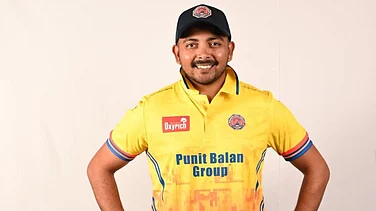NAVJOT Singh Sidhu is the mystery man of Indian cricket. Now you see him, now you don't. Having made his Test debut in 1983, he’s the most weather-beaten hand in the current team. Yet, over these dozen years, the Indian eleven has often walked out to play with his tall, wiry frame conspicuous by its absence.
Derided as a "strokeless wonder" in his salad days, he was soon making curry of the best of bowlers—becoming the Indian spectator’s delight as a crack six-shooter. Once dubbed suspect against pace, he was solid enough to smash a century against the West Indies on the blazing pitch of Kingston, Jamaica, in 1989.
And he can do much more than hoist the cherry over long on: the toothy grimace behind the vizor makes for a picture of fierce concentration and, for one, this has translated into more one-day centuries than by any other Indian batsman.
Sidhu is back in the news at the start of the season. Chosen as the Rest of India captain for the pipe-opener Irani Trophy tie against Bombay early last month, the selectors were put in a spot when he withdrew with a foot injury he allegedly suffered at the Madras training camp. G.R. Vishwanath and company were apparently unaware that Sidhu had carried the injury through the camp and, despite signs of improvement, he was not fit enough to pass a test.
Now Sunil Gavaskar has put the cat among the pigeons by insinuating that Sidhu is being sidelined because of problems with captain Mohammed Azhar-uddin. He alleged in his syndicated column that Sidhu was dropped for the first Test against New Zealand despite being fit. "There is going to be a feeling that unless you are a yes-man you are going to be cast aside even if you have the performance to back you," Gavaskar wrote.
Azhar and manager Ajit Wadekar were quick to respond. "Who can keep a player like Sidhu out if he is fit?" Wadekar asked. "Sidhu had himself faxed the doctor's advice that he should not take any undue risks until fully fit," he told the press on the opening day of the first Test.
Gavaskar evaded further comment, citing "contractual obligations" which forbid him from being quoted. But the controversy he set off wasn’t laid to rest till Sidhu’s last-minute inclusion for the Madras Test.
The introverted Sidhu has been averaging in the 40s in both Test cricket and its abbreviated counterpart. Why then does a cloud hang over him, with doubts over his fitness extending to his commitment?
Amrit Mathur, manager on the 1992 South Africa tour, vouches for Sidhu. "He’s a bit of a loner, a family man who prefers to stay in Patiala. He isn’t interested in masala cricket or the counties. All this negative talk is unjustified, baseless. Just look at his track record. That should be the bottomline."
What about his alleged habit of coming late for camps? "He missed one session of one camp in Delhi. Others have been known to come days late. How can this be held against him?" Mathur asks.
He ranks Sidhu as the best batsman in the team after Azhar and Sachin Tendulkar. "Sidhu has scored a century in the West Indies. Even Azhar hasn’t managed that," adds Mathur. "Maybe he is injury-prone. But he has never ducked a match."
Abbas Ali Baig, who as manager flew in Sidhu for an injured Ravi Shastri during the 1992-93 Australia tour, agrees: "He’s a particularly dedicated cricketer who took great pains to improve his fielding." He also affirms that Sidhu "isn’t the type to feign an injury. It’s hardly his fault if he is injury-prone and, as far as I am concerned, he should be a regular in the team."
One perennial Sidhu critic is bowling great Bishan Singh Bedi, who managed the team to New Zealand and England in 1990. But a Cricket Board member puts this all down to the power struggle within Punjab cricket circles.
Coming back to the Madras camp, it appears strange that while the board was making a fetish of fitness, Azhar and others were playing in the lucrative Hong Kong Sixes tournament. Again, the Rest team is traditionally led by the India captain if he is not leading the Ranji champions. Azhar and company were back in time for the match. Why then was Sidhu asked to lead? Was one of India’s most consistent batsmen being put on trial?






















